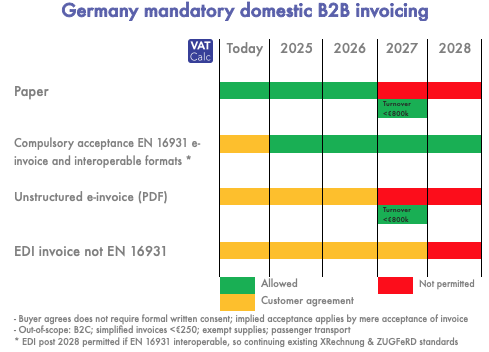Federal Government: Jan 2025 obligations may be covered by dedicated e-mail box for suppliers’ structured electronic invoices
The first phase of German e-invoicing mandate starts on 1 January 2025. All German resident taxpayers must be able to receive structured, or machine readable, electronic invoices.
Following questions raised by the CDU/CSU parliamentary group and acknowledgement by Ministry of Finance (Bundesministerium der Finanzen BMF) of slow progress towards compliance. In response, the BMF has said that “The provision of an e-mail inbox is sufficient for the receipt of an e-invoice” Alternatively, taxpayer counter parties may agree on other electronic data exchange methodologies.
However, it should be noted though that the real challenge lies in the proper storage and further processing of the invoices received. Without structured storage and a suitable viewer for XML-based invoice formats, it becomes complicated to access the necessary documents quickly and efficiently in the event of an audit. Therefore, the receipt of e-invoices should only be considered as the first step
The BMF will shortly issue:
- Technical and regulatory requirements;
- Frequently Asked Questions (FAQ).
But the BMF confirmed that it will not be providing free tools for small businesses to comply with the new mandate. The new rules come into force between 2025 and 2028, culminating in the full withdrawal of paper invoices.

Minimum fulfilment of 2025 e-invoicing obligations
From 1 January 2025, companies subject to VAT in Germany will be mandated to accept e-invoices in a structured, machine-readable format such as XML. This transition will streamline compliance with the EU Directive on VAT e-invoicing for domestic B2B transactions. The German Federal Government has clarified that a separate IT system is not strictly necessary for businesses to fulfill this requirement. In its response to an inquiry from the CDU/CSU parliamentary group, the government stated that providing an e-mail inbox is sufficient for receiving e-invoices, though companies may opt for more sophisticated transmission channels like electronic interfaces or dedicated portals.
The e-invoice formats recognised by the German tax authorities include XRechnung and Zugferd (from version 2.0.1), both of which comply with the VAT Directive’s requirement for a structured electronic format. These formats ensure that the invoice data is transmitted in an XML schema, facilitating automatic processing by accounting software. Other European e-invoicing standards, such as Italy’s FatturaPA or France’s Factur-X, may also be acceptable, although specific national requirements must be met.
Under the principles of proper electronic bookkeeping (GoBD), e-invoices must not only be transmitted electronically but also stored in electronic form. This ensures that data remains accessible and audit-proof, aligning with Germany’s regulatory framework for electronic records. Importantly, there will be no transition period for the receipt of e-invoices, meaning businesses must be ready to receive them by January 1, 2025. The only exemption applies to invoices below €250, which do not need to comply with the full e-invoicing standards. Moreover, companies with annual revenues under €800,000 may continue to use non-structured formats, such as PDFs, until the end of 2027.
The CDU/CSU parliamentary group expressed concerns about the lack of a unified VAT system across the EU, adding further complexity to the implementation of e-invoicing requirements. The EU VAT in the Digital Age reforms includes such a plan, but only for intra-community invoices from 2030 under the Digital Reporting Requirements pillar 1.
While there were suggestions for the government to provide free tools for e-invoice creation and visualization, the BMF has decided against offering a state-run service, citing competition with private providers. Many online services, some of which are free, are already available from commercial vendors, reducing the need for government intervention in this area.




